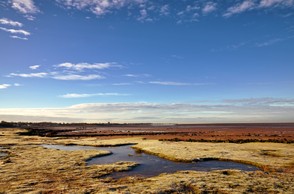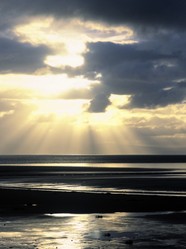I particularly enjoyed the chapter, Testing the Sands, whose subject is a walk with the Queen's Guide. There are several of these guides, each of whom specializes in a particular route across the sands, and who must guide people across the potentially deadly crossing. The post dates back to the sixteenth century, and comes with a free cottage and four fields. While I knew of the dangers of the sands, this chapter taught me much that I did not know.
We meet Cedric,the Queen's Guide, in his eighties but still hale and hearty, with the physique of a man half his age, a testimony to healthy outdoor living. The role was established when the alternative path along the shore was fraught with highwaymen and often boggy, and in that era the Queen's guide probably carried a gun and a sword. He, some assistants and the author set out on one of his regular trips re-establishing the pathway through the ever-changing sands, that can alter in a single night and which certainly alter greatly after a storm. They use brobs, markers made of branches of laurel, whose leaves do not rot when water-covered, to mark out the pathway.This is an ancient technique also used on Britain's most dangerous path, the Broomway in Essex.
But we are introduced to the lethal dangers of the sands. The ever-shifting quicksands we all know about, but did we know of belgraves? I did not. These are water filled holes that are big enough to swallow a tractor and sometimes have done so. You cannot know their depth until you drive into one. Cedric tells of how one of his colleagues once drove into a belgrave.Summoning his strength, the powerful swimmer struck for the surface and was pulled out by his relieved work mates. The tractor was never seen again, engulfed by the shifting sands. Those not familiar with the sands also may not know that they can be deeply rutted and that it is difficult to get tractors across.
The waters are dangerous, Cedric tells us.The shifting sands alter the course of the rivers that flow into the bay, and after one storm the course of one changed by several miles. The direction of the wind can alter surface conditions, even changing the width of the rivers, from narrow and fast to broad and slow. The tide comes a-racing across the surface, there is a tidal bore,a surging wave in some conditions that can race faster than a man can run, a snare for the unwary.
Cedric is a survivor. Once when he took his twelve year old daughter shrimping in the bay, a sudden mist fell on them, so thick that they could see no lights on the shore. For most of us that would be the end, trapped in a wilderness. But Cedric guided them out to safety. merely by using the sound of the river, assessing where they were by its change of direction. Expert local knowledge.








 Pilgrimage. A review15 days ago
Pilgrimage. A review15 days ago
 Leo the Fourteenthon 05/09/2025
Leo the Fourteenthon 05/09/2025
 The Melsonby Hoardon 03/25/2025
The Melsonby Hoardon 03/25/2025



Comments
Yes, it is easy to generalise.
Thank you for your comment below in answer to my previous observation and question.
Me too, I'm not comfortable with stereotypes even as I laugh from time to time over one from my stay in Brazil.
A bus ride from Rio de Janeiro all the way to Todos os santos near Salvador, Brazil and then a ferry from that bay to Itaparica island meant my sister and I as the only non-Brazilians.
The passengers noticed our quietness and opted for that quietness as continental Portuguese traits!
(Portuguese- and Spanish-speakers tend to think of me on my travels there as from Argentina or Portugal!)
I do not place great value on stereotypes. I recall catching a coach in Manchester to go on holiday to South West England. I was the only Englishman aboard, the rest were Scots, and what a friendly and lively crew they were. It was the jolliest coach ride I have ever made.
That's quite a compliment from what Unitedstatesians generally stereotype Scots-wise as taciturn!
Another Unitedstatesian stereotype presents Irish as more outgoing, even more spontaneous than Scot counterparts.
Would that be accurate always, never, or only during St. Patrick's celebrations ;-D!?
There are cultural affinities between the North of England and southern Scotland. When my son studied Horticulture in southern Scotland his Scots friends said that he was more like a Scot than the rest of the English students were. He was the only northern Englishman there.
Thank you for your comment below in answer to my previous observation and question.
Cumberland and Northumberland border the Scottish counties of Dumfriesshire, Roxburghshire and Berwickshire.
Does the aforementioned quintet similarize one another culturally?
The counties of Cumberland, Westmoreland, Lancashire , Yorkshire, Durham, Northumberland, and Cheshire are the North of England.
The introductory paragraph advises us that "The North of England is not regarded as a fashionable place to be."
What parts of England does the north comprise?
Thank you for your comment below on Jan. 23, 2021, in answer to my previous, same-day question.
How disappointing! No "specially environmentally friendly way of pumping" does not go -- if one likes wolves as I do even as perhaps it does go if one dislikes wolves as I don't -- with the English Wikipedia-defined etymology of Ulpha as originating in Old Norse ulfr haugr ("wolves hill").
So is the pumping equipment environmentally-unfriendly in its design and operation or is it the way that it's implemented that's either environmentally-friendly or unfriendly?
I don't think that Ulpha Farm has a specially environmentally friendly way of pumping. It is not the same water that recycles, but rainwater from the hills that flows down.